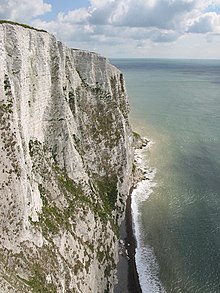White cliffs of Dover
The White Cliffs of Dover (Engl. White Cliffs of Dover ) are bright white cliffs , the part of the British form of coastline and over the road from Dover to France look. They are part of the North Downs range of hills.
The up to 106 meter high front of the cliffs owes its appearance to its composition of lime (pure white calcium carbonate ), interspersed with black flint . The cliffs run east and west of the town of Dover in County Kent , an ancient and still important English port.
The chalk cliffs are of great symbolic value for Great Britain, as they face continental Europe on the narrowest part of the English Channel and therefore represented a symbolic protection against impending invasions in the past. As the crossing of the canal at Dover is the most popular sea route between the mainland and the British Isles, the white line of the cliffs gives many travelers their first or last view of the United Kingdom.
location
The cliffs extend roughly between 51 ° 06 'N, 1 ° 14' E and 51 ° 12 'N, 1 ° 24' E along the southern coast of England. The point where England is closest to continental Europe (33 km) is called Shakespeare Cliff . They are easy to see from France on a clear day.
geology
The chalk cliffs are composed primarily of coccoliths and trace their origins back to the Cretaceous about 136 million years ago, when the area between Great Britain in the west and Sweden and Poland in the east was deep in tropical waters. The skeletons of corals , sponges and other small sea creatures sank as sediment to the sea floor and began to pile up there. By about 70 million years ago, this process had formed a mass of silica-spotted limestone that covered vast areas between Great Britain and the Baltic Sea - white rocks like Dover, albeit smaller, can also be found on the Danish islands of Møn and Langeland or the coast of Rügen can be found in Germany. The chalk layer was high above sea level during the Ice Ages and in some places was also covered by glaciers. After the ice ages they were then exposed to the rising sea. The extraordinary softness of the limestone has since enabled the tides to erode this landmass to a significant extent, including to form the English Channel.
The front of the rocks continues to be eroded, about one centimeter of the rocks is lost every year, although occasionally (most recently in 2001) large chunks fall into the channel with little warning. Visitors are therefore advised to stay at least five meters from the edge.
ecology
Several species of birds nest in the front of the chalk cliffs, including fulmars ( Fulmarus glacialis ) and colonies of kittiwakes . Contrary to the statement of the famous song ( "There'll be bluebirds over the white cliffs of Dover"; "The Bluebird flying over the white cliffs of Dover") are Bluebird an American species that is not found in the UK .
defense
Behind the front of the cliffs are miles of hidden tunnels that were dug in the Middle Ages and played a role in defending Britain during the Napoleonic Wars . Later extensions made the tunnels what is now the Secret Wartime Tunnels under Dover Castle .
Cultural references
In Matthew Arnold's 1867 poem, Dover Beach , the rocks are a sign of reassuring strength. Rudyard Kipling's poem " The Broken Men " (1902) ends with the verses "How stands the old Lord Warden ? Are Dover's cliffs still white?" and expresses the homesickness of an exiled Englishman. Perhaps the most distinctive reference is the World War II song " (There'll Be Bluebirds Over) The White Cliffs of Dover, " sung by Vera Lynn .
Even Glenn Miller , Kay Kyser , Kate Smith , Blur , The Decemberists , Louis Prima , Robson and Jerome , Clutch , Andrew Bird , Coil , Current 93 and Fatboy Slim have been covered this song or even sung over the cliffs.
In Ian Fleming's third James Bond novel, Moonraker , a chapter takes place on the cliffs. The villain tries to kill Bond and Gala Brand by bombing the rocks, hoping the protagonists will be hit by rubble.
In a 2005 Radio Times poll, the cliffs were named the third largest natural wonder in Britain.
The instrumental song "Cliffs of Dover" by the American guitarist Eric Johnson is named after the cliffs.
The writer Ilse Aichinger , who already wrote in her novel “ The Greater Hope ” that “[e] a fly [...] from Dover to Calais [crawled]”, wrote a short text in 1976 with the title “Dover”.
See also
Web links
Individual evidence
- ↑ The eroding of the chalk cliffs. Retrieved April 28, 2017 .
- ↑ Aichinger, Ilse: The greater hope , Fischer: Frankfurt am Main 1991, p. 9.
- ↑ Cf. Aichinger, Ilse: “Dover”, in: Schlechte Wort, Fischer: Frankfurt am Main 1991, pp. 41--44.
Coordinates: 51 ° 8 ′ 24 ″ N , 1 ° 22 ′ 12 ″ E







